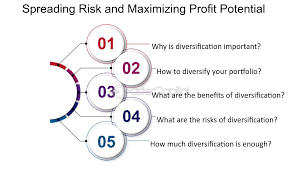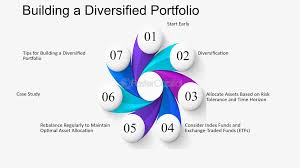A diversified portfolio is considered essential for managing investment risk effectively. By spreading investments across various asset classes, sectors, and geographic regions, the potential for loss is mitigated. This approach reduces the impact of poor performance in any single investment on the overall portfolio.
The Importance of Diversification
Diversification is often referred to as a fundamental principle of investing. It is widely believed that by holding a variety of investments, the risk associated with individual assets is lessened. Historical data has demonstrated that portfolios with a higher degree of diversification tend to experience less volatility compared to those with concentrated investments.
Asset Allocation
The process of building a diversified portfolio typically begins with asset allocation. Different asset classes, such as equities, bonds, real estate, and cash, are included. Each asset class behaves differently under various economic conditions. For instance, while stocks may offer higher returns, they are also associated with higher volatility. Conversely, bonds tend to provide stability but offer lower returns.
Equities
Stocks or equities are commonly included in diversified portfolios. They provide the potential for high returns but are also subject to market fluctuations. By investing in a mix of domestic and international stocks, exposure to various economic conditions and markets is achieved. This strategy ensures that the performance of one region or sector does not disproportionately affect the overall portfolio.
Bonds
Bonds are another critical component of a diversified portfolio. They are known for their stability and income generation. Bonds can be issued by governments, municipalities, or corporations, each offering varying levels of risk and return. A well-diversified bond portfolio might include a mix of government and corporate bonds with different maturities and credit qualities.
Real Estate
Real estate investments can also be utilized to diversify a portfolio. Real estate properties or real estate investment trusts (REITs) provide income through rent and have the potential for capital appreciation. By including real estate, an investor gains exposure to an asset class that often behaves differently from stocks and bonds.
Cash and Cash Equivalents
Cash and cash equivalents, such as savings accounts or money market funds, are included in portfolios to provide liquidity and safety. These assets are low-risk and can be easily converted into cash when needed. They serve as a buffer during periods of market volatility and offer stability to the overall portfolio.
Geographic Diversification
Geographic diversification is an essential aspect of portfolio construction. Investing in international markets allows exposure to economic growth outside of the domestic economy. Global diversification can reduce the impact of regional economic downturns and provide access to emerging markets with higher growth potential.
Sector Diversification
Sector diversification involves spreading investments across various industries. Different sectors, such as technology, healthcare, and consumer goods, perform differently based on economic cycles. By avoiding over-concentration in one sector, the portfolio is protected from sector-specific risks.
Risk Tolerance and Time Horizon
Individual risk tolerance and time horizon play a significant role in portfolio diversification. Risk tolerance refers to an investor’s ability and willingness to endure market fluctuations. A higher risk tolerance may lead to a portfolio with a higher allocation to equities, while a lower risk tolerance might favor bonds and cash.
The time horizon, or the length of time an investor plans to hold investments, also influences diversification. For long-term goals, such as retirement, a higher allocation to growth-oriented assets may be appropriate. Conversely, for short-term goals, a more conservative approach with a higher allocation to cash and bonds may be preferred.
Regular Rebalancing
Regular rebalancing is necessary to maintain the desired asset allocation. Over time, the performance of various investments will cause the portfolio to drift from its original allocation. Rebalancing involves adjusting the portfolio to return to the intended asset mix, ensuring that it remains aligned with the investor’s goals and risk tolerance.
Monitoring and Adjusting
Building and maintaining a diversified portfolio requires ongoing monitoring and adjustment. Changes in economic conditions, market trends, and personal circumstances can necessitate adjustments to the portfolio. Periodic reviews are conducted to ensure that the portfolio continues to meet the investor’s objectives.
Investment Vehicles
Several investment vehicles can be utilized to achieve diversification. Mutual funds and exchange-traded funds (ETFs) are popular choices. These funds pool money from multiple investors to invest in a diversified portfolio of assets. Mutual funds are managed by professional fund managers, while ETFs are traded on exchanges and offer flexibility in buying and selling.
Costs and Fees
When building a diversified portfolio, costs and fees are important considerations. Investment management fees, transaction costs, and fund expenses can impact overall returns. It is essential to be aware of these costs and choose investment options that align with the investor’s goals and budget.
Tax Implications
Tax implications should also be considered in portfolio construction. Different types of investments may be subject to varying tax treatments. For example, interest from bonds may be taxed at ordinary income rates, while long-term capital gains from stocks may benefit from lower tax rates. Tax-efficient investment strategies can enhance after-tax returns.
Spreading Risk and Maximizing Profits in the Stock Market

In the realm of stock market investments, effective strategies for spreading risk and maximizing profits are often employed. The principles guiding these strategies are designed to mitigate potential losses while optimizing returns.
The concept of diversification is frequently utilized to spread risk. By investing in a variety of assets, the overall risk associated with any single investment is reduced. Stocks from different sectors, industries, or geographical regions are typically included in diversified portfolios. This practice ensures that adverse performance in one sector does not unduly impact the overall portfolio. Diversification is widely recognized as a fundamental principle in risk management.
In addition to diversification, the allocation of assets across various investment categories is carefully managed. Asset allocation involves distributing investments among different asset classes, such as equities, bonds, real estate, and cash. The aim of this approach is to balance risk and reward according to an investor’s risk tolerance and investment goals. Strategic asset allocation is often guided by research and historical performance data, which helps in making informed decisions.
Risk tolerance plays a crucial role in determining the appropriate investment strategy. Investors with a higher risk tolerance may be inclined to invest a larger portion of their portfolio in high-growth stocks or speculative investments. Conversely, those with a lower risk tolerance might prefer safer investments, such as government bonds or blue-chip stocks. The alignment of investment choices with individual risk tolerance is essential for achieving desired outcomes.
Maximizing profits in the stock market involves not only managing risk but also identifying and capitalizing on growth opportunities. Fundamental analysis is frequently employed to assess the intrinsic value of stocks. This analysis involves evaluating financial statements, earnings reports, and other relevant data to determine whether a stock is undervalued or overvalued. Stocks that are deemed undervalued are often targeted for investment, with the expectation that their market value will increase over time.
Technical analysis is another method used to maximize profits. This approach involves analyzing historical price movements and trading volumes to predict future price trends. Charts, indicators, and patterns are examined to identify potential entry and exit points for trades. Technical analysis is often used in conjunction with fundamental analysis to make well-rounded investment decisions.
The concept of compounding returns is also instrumental in profit maximization. By reinvesting earnings, such as dividends or interest payments, investors can benefit from the growth of their investments over time. The power of compounding is significant, as it enables investments to grow exponentially rather than linearly. This principle is widely acknowledged in long-term investment strategies.
Regular monitoring and rebalancing of portfolios are essential practices for maintaining an optimal investment strategy. Market conditions and individual asset performance can fluctuate, necessitating adjustments to the portfolio to stay aligned with investment goals. Periodic reviews and rebalancing help ensure that the portfolio continues to reflect the desired risk-reward profile.
The use of stop-loss orders is another technique employed to manage risk. A stop-loss order is designed to automatically sell a stock when its price falls to a predetermined level. This tool helps prevent excessive losses by limiting the potential downside of an investment. While stop-loss orders can protect against significant losses, they may also result in the sale of assets at inopportune times if market conditions are volatile.
Risk management also involves understanding and mitigating various types of risks. Market risk, which refers to the risk of losses due to overall market fluctuations, is a primary concern for investors. Additionally, interest rate risk, credit risk, and liquidity risk are other factors that can impact investment performance. Diversification and asset allocation strategies are often employed to address these risks and maintain a balanced portfolio.
Investors are also advised to remain informed and educated about market trends and economic conditions. Staying updated on financial news, economic indicators, and corporate developments can provide valuable insights for making informed investment decisions. Knowledge of market dynamics and industry trends helps investors anticipate potential opportunities and challenges.
Behavioral biases can impact investment decisions and affect the effectiveness of risk management strategies. Emotional reactions, such as fear or greed, can lead to impulsive decisions and deviations from a well-considered investment plan. Awareness of these biases and adherence to a disciplined investment approach are essential for achieving long-term success in the stock market.
In conclusion, spreading risk and maximizing profits in the stock market are achieved through a combination of diversification, strategic asset allocation, risk tolerance assessment, and informed decision-making. Diversification and asset allocation are fundamental practices for managing risk and optimizing returns. Techniques such as fundamental and technical analysis, compounding returns, and regular portfolio monitoring contribute to profit maximization. By understanding and addressing various risks, staying informed, and avoiding behavioral biases, investors can enhance their chances of achieving favorable investment outcomes.
Conclusion
In conclusion, building a diversified portfolio involves spreading investments across various asset classes, sectors, and geographic regions to manage risk effectively. Asset allocation, risk tolerance, and time horizon are key factors in portfolio construction. Regular rebalancing, monitoring, and adjusting are necessary to maintain diversification and align with investment goals. By employing these strategies, investors can achieve a well-balanced portfolio that provides stability and growth potential.










